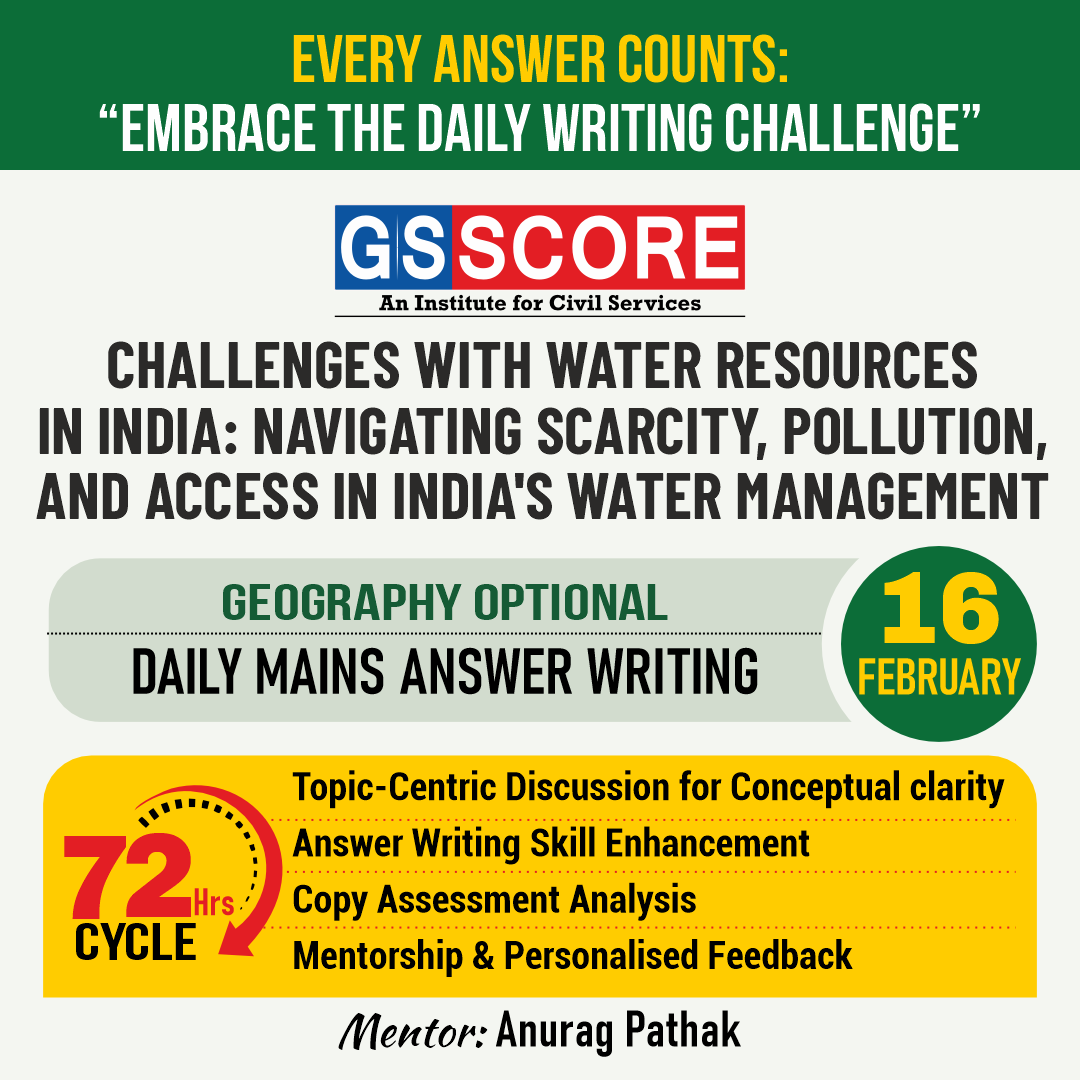

Geography Optional (Challenges with Water Resources in India: Navigating Scarcity, Pollution, and Access in India's Water Management) by Anurag Pathak

Instruction:
- There will be 2 questions carrying the First Question is-10 marks Write your answers in 150 words and the Second Question is-15 marks Write your answers in 250 words.
- Any page left blank in the answer-book must be crossed out clearly.
- Evaluated Copy will be re-uploaded on the same thread after 2 days of uploading the copy.
- Discussion of the question and one to one answer improvement session of evaluated copies will be conducted through Google Meet with concerned faculty. You will be informed via mail or SMS for the discussion.
Question #1. Critically evaluate the factors contributing to water scarcity in India, with a specific focus on spatial and temporal variations. 10 marks (150 words)
Question #2. Analyse the linkages between water resource management and climate change in India. Discuss the impact of climate change on water availability and quality, and suggest adaptation strategies for a more sustainable future. 15 marks (250 words)
(Examiner will pay special attention to the candidate's grasp of his/her material, its relevance to the subject chosen, and to his/ her ability to think constructively and to present his/her ideas concisely, logically and effectively).
STEPS & INSTRUCTIONS for uploading the answers
Step 1 - The Question for the day is provided below these instructions. It will be available at 7:00 AM.
Step 2 - Uploading of Answers : Write the answer in A4 Sheet leaving proper margins for comments and feedback and upload the PDF in MY ACCOUNT section. Click on the option of SUBMIT COPY to upload the PDF.
Step 3 - Deadline for Uploading Answers: The students shall upload their answers by 7:00 PM in the evening same day. The first 50 copies will be evaluated.
Step 4 - Feedback : Mentors will give their feedback for the answers uploaded. For more personalised feedback, join our telegram channel by clicking on the link https://t.me/mains_answer_writing_cse . A one-to-one session will be conducted with the faculty after copy evaluation in 72 Hrs.
Model Answer
Question #1. Critically evaluate the factors contributing to water scarcity in India, with a specific focus on spatial and temporal variations. 10 marks (150 words)
Spatial Variations:
- Himalayan region: Abundant water resources due to snowmelt, but limited infrastructure and population pressure create challenges.
- Thar Desert: Scarce rainfall and limited surface water resources pose significant challenges for agriculture and livelihoods.
- Gangetic plains: Intensive agriculture and high population density lead to overexploitation of groundwater, impacting long-term sustainability.
- Coastal regions: Vulnerable to saltwater intrusion due to overextraction and rising sea levels, affecting drinking water access.
- Urban areas: Rapid urbanization increases water demand for domestic and industrial uses, while inadequate infrastructure creates distribution challenges.
Temporal Variations:
- Monsoons: Unpredictable monsoon patterns contribute to droughts and floods, affecting overall water availability and agricultural productivity.
- Climate change: Rising temperatures lead to increased evaporation and reduced snowfall, exacerbating water scarcity in vulnerable regions.
- Glacial retreat: Melting glaciers in the Himalayas reduce longterm water storage capacity, impacting downstream water flows.
- Shifting agricultural practices: Increased water-intensive crops and unsustainable irrigation methods contribute to declining groundwater levels.
- Industrial water demand: Growing industries put increasing pressure on water resources, particularly in water-stressed regions.
Analysis:
- Inadequate infrastructure: Insufficient storage capacity, leaky irrigation systems, and limited wastewater treatment contribute to water losses and inefficient management.
- Policy shortcomings: Weak enforcement of water regulations, lack of integrated water management plans, and inadequate investment in infrastructure hinder progress.
- Unequal access and distribution: Rural communities and marginalized groups often face limited access to safe drinking water and sanitation, despite spatial variations in availability.
Overall Conclusion:
- Water scarcity in India is a complex issue with diverse contributing factors, both spatial and temporal.
- Understanding these variations is crucial for designing effective solutions that address regional disparities and ensure equitable access to water resources.
- Addressing unsustainable water use practices, improving infrastructure, and implementing robust water management policies are essential for mitigating water scarcity and ensuring water security for all in India.
Question #2. Analyse the linkages between water resource management and climate change in India. Discuss the impact of climate change on water availability and quality, and suggest adaptation strategies for a more sustainable future. 15 marks (250 words)
Impacts of Climate Change on Water:
- Reduced Availability:
? Increased temperatures & erratic precipitation patterns lead to decreased water quantity.
? Glacial retreat in Himalayas reduces long-term water storage capacity.
? Increased evaporation and transpiration further deplete water resources.
- Degraded Quality:
? Extreme weather events (floods, droughts) contribute to increased water pollution.
? Salinization of coastal aquifers due to rising sea levels threatens drinking water supplies.
? Changes in temperature and precipitation affect water quality through algal blooms and altered ecosystems.
Management Challenges:
- Increased demand: Growing population and economic activity exacerbate water stress under climate change.
- Infrastructure strain: Existing infrastructure (dams, canals) may not be resilient to climate extremes.
- Policy inadequacy: Current water management policies may not be adapted to address climate impacts.
- Competing needs: Balancing water needs for agriculture, industry, and domestic use becomes more complex.
Adaptation Strategies:
- Water Conservation: Promote rainwater harvesting, efficient irrigation methods, and water-saving technologies.
- Infrastructure Improvement: Invest in climate-resilient infrastructure like storage facilities and flood management systems.
- Policy and Governance: Develop integrated water management plans considering climate projections and vulnerabilities.
- Community-Based Action: Empower local communities in water resource management and adaptation efforts.
- Demand Management: Promote water pricing reforms and awareness campaigns to encourage responsible water use.
Key Points:
- Climate change significantly impacts water availability and quality in India, posing major challenges for sustainable management.
- Effective adaptation strategies require integrated approaches at various levels, from infrastructure development to policy reform and community engagement.
- Prioritizing water conservation, resilient infrastructure, and inclusive governance is crucial for securing water security in a changing climate.

